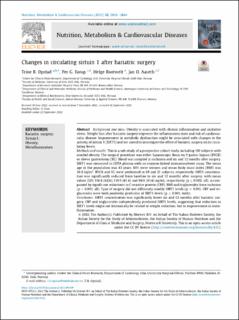Changes in circulating sirtuin 1 after bariatric surgery
Peer reviewed, Journal article
Published version
Permanent lenke
https://hdl.handle.net/11250/3035133Utgivelsesdato
2022Metadata
Vis full innførselSamlinger
Originalversjon
NMCD. Nutrition Metabolism and Cardiovascular Diseases. 2022, 32 (12), 2858-2864. 10.1016/j.numecd.2022.09.009Sammendrag
Background and aims: Obesity is associated with chronic inflammation and oxidative stress. Weight loss after bariatric surgery improves the inflammatory state and risk of cardiovascular disease. Improvement in metabolic dysfunction might be associated with changes in the activity of sirtuin 1 (SIRT1) and we aimed to investigate the effect of bariatric surgery on its circulating levels. Methods and results: This is a sub-study of a prospective cohort study, including 110 subjects with morbid obesity. The surgical procedure was either laparoscopic Roux-en-Y gastric bypass (RYGB) or sleeve gastrectomy (SG). Blood was sampled at inclusion and six and 12 months after surgery. SIRT1 was measured in EDTA plasma with an enzyme-linked immunosorbent assay. The mean age in the population was 43 years, 80% were women and mean body mass index (BMI) was 38.8 kg/m2. RYGB and SG were performed in 89 and 21 subjects, respectively. SIRT1 concentration was significantly reduced from baseline to six and 12 months after surgery, with mean values (SD) 156.8 (82.6), 119.5 (65.6) and 94.9 (45.6) ng/mL, respectively, (p 0.002, all), accompanied by significant reductions in C-reactive protein (CRP), BMI and triglycerides from inclusion (p < 0.001, all). Type of surgery did not differently modify SIRT1 levels (p Z 0.09). CRP and tri glycerides were both positively predictive of SIRT1 levels (p 0.001, both). Conclusion: SIRT1 concentration was significantly lower six and 12 months after bariatric surgery. CRP and triglycerides independently predicted SIRT1 levels, suggesting that reduction in SIRT1 levels might not intrinsically be related to weight reduction, but to improvement in metaflammation.

